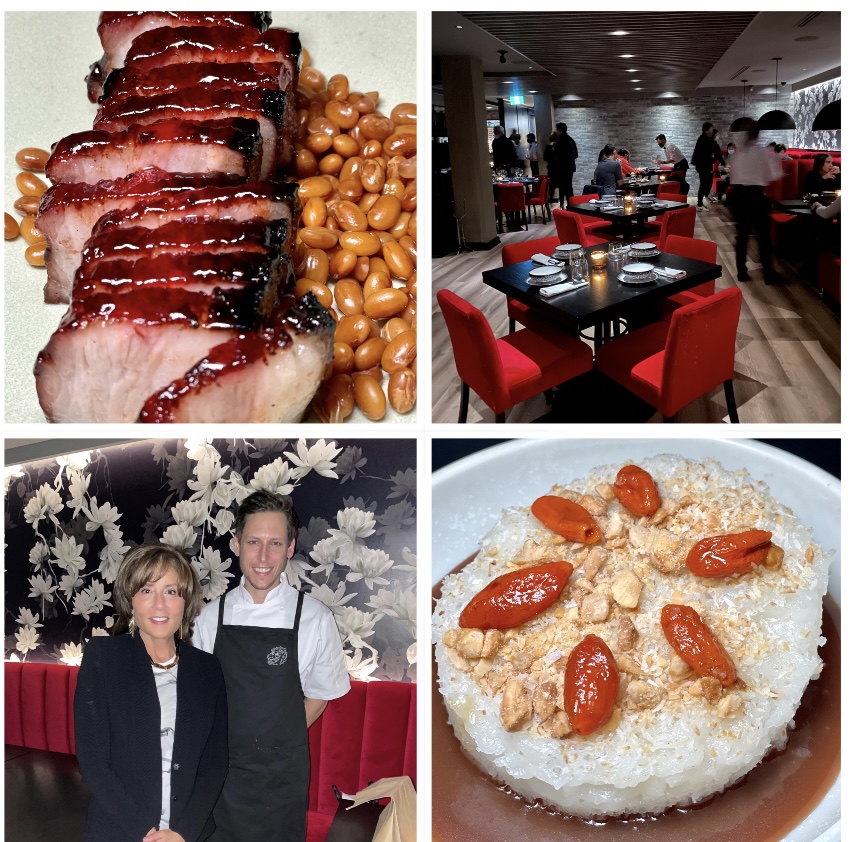

Bold, dynamic, exhilarating and complex, are some of the words to describe the tantalizing flavours of the dishes we savoured at Toronto’s new hot spot, Mimi Chinese, at 265 Davenport Road, in the former home of Mistura.
I’m not surprised by my reaction at all. I’ve been following Chef David Schwartz around for years. He first was, in his early twenties, the head chef of Omaw Restaurant on Ossington, which was fabulous. He has been working on this new project for about 2 1/2 years after traveling extensively in China, and then COVID hit. So he opened a pop-up called, “Sunny Chinese”, and worked out of the back of the Mistura kitchen providing takeout meals for fellow foodies like me. They sold out quickly and had people clamoring for more. It was a great testing ground for Mimi Chinese. Now David is 29, but he cooks like a deeply knowledgeable chef with a well-earned reputation.
Mimi Chinese is a dramatically beautiful, upscale space. Not your parents’ typical House of Chan, China House, or Sea Hi.
The restaurant’s colour palette is black, red, and white. Black walls, dark floors, red velvet banquets, black and white lotus motifs on the walls. Dim recessed, sexy lighting, and a large exhibition window into a pristine kitchen, where you can see different stations busy at work. They must have great ventilation because there were no smells coming into the dining area. I love the details, the black and white attractive dishware, black chopsticks, and dark cutlery. The staff wears white shirts and bowties. There is a great soundtrack playing, a lot of my music from the ’80s. The volume goes up as the evening progresses.
The menu showcases regional Chinese dishes, but many lean towards Guangdong Province. The food is authentic and traditional with some modern updating and twists. None of the deep-fried, salty glop you remember from your youth. Dishes are meant to be shared as in traditional Chinese restaurants.
The menu is divided into Raw and Cooling, Savoury and Warming, Noodles, Rice, Vegetables, and the chef’s large-format specials. Try and experience something from each section if you can to immerse yourself in the full experience. Of course, we ordered way too much but were able to finish almost everything because it was so delicious.
 We started with the smacked cucumber salad. A lovely refreshing and light mixture of wood ear mushrooms, chrysanthemum, cucumbers, and Shanxi vinegar, from Sichuan Province. Next up, scallion and ginger scallops from the Guangdong Province. I’m always a sucker for raw scallops, and these were done in a scallion oil, soy broth, and Chinese crispy donuts on top. A standout was the sea bream Kuai style, with tiny chopped cucumbers, ginger, and soybean from the Guangdong Province.
We started with the smacked cucumber salad. A lovely refreshing and light mixture of wood ear mushrooms, chrysanthemum, cucumbers, and Shanxi vinegar, from Sichuan Province. Next up, scallion and ginger scallops from the Guangdong Province. I’m always a sucker for raw scallops, and these were done in a scallion oil, soy broth, and Chinese crispy donuts on top. A standout was the sea bream Kuai style, with tiny chopped cucumbers, ginger, and soybean from the Guangdong Province.
From the savoury section, we adored the shrimp toast, bread that is stuffed with chopped shrimp, and red vinegar. It is and flash-fried and then rolled in sesame seeds, and served with a yummy hot mustard mayo. This is a must-order. From the large format specials, we ordered the hidden crispy chicken. But beware, it is hidden beneath chilies, garlic, and spices and has quite a bite to it. This section is where you will find fish and a few types of beef. They will be changing things up and adding lobster and different dishes they are testing out. Another standout from this section is the House Char Siu Pork. Also from the Guangdong Province, it is braised, marinated, and roasted twice and is finished with Ontario wildflower honey and accompanied with sweet caramelized soybeans. It’s juicy, fatty, rich, succulent, and fabulous. The vegetable fried rice from the Hunan Province was also a good choice to balance with all the dishes we ordered. But next time I must try the four-foot belt noodles. We also had a side with chili shrimp oil, oyster sauce, and fermented mustard greens.
There are three dessert offerings. We tried the sticky rice with brown sugar caramel, coconut, and almond.
There is an extensive sake list, two pages long, as well as a nice selection of white wines that pair well with the food. They didn’t forget the red wine lovers either, with global selections available. There are exclusive hand-crafted cocktails made with Chinese ingredients as well as a traditional bar. I tried a Jasmine Reviver, made with gin, lemon, vermouth, and jasmine. It had light floral notes with a nice citrusy finish. The signature cocktail, Jungle Panda, is an ode to China’s national animal and comes in an adorable panda bear container. It’s a refreshing cocktail with notes of lychee, lime, and mandarin and contains rum, baijiu, elderflower, and Campari. Executive chef, David Schwartz, and executive sous chef, Branden Chong know how to cook and how to combine an interplay of textures and flavours with a twist on traditional dishes and the culture of this fascinating cuisine.
Recommend!
Happy dining,
Shanea
3 Comments
Hey Shanea this is exciting. We actually drove into Toronto twice during Covid to pick up from Sunny Chinese.
jobs Chinese chef cook ???
Very nice post. I just stumbled upon your blog and wanted to say that I’ve really enjoyed browsing your blog posts. In any case I’ll be subscribing to your feed and I hope you write again soon!